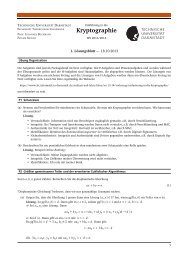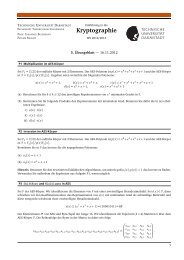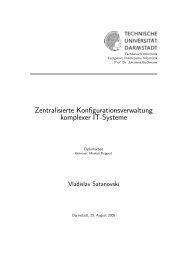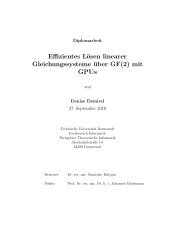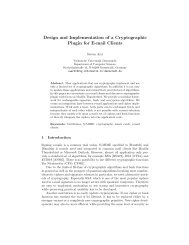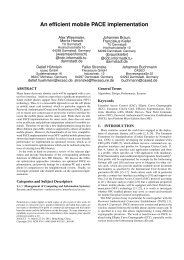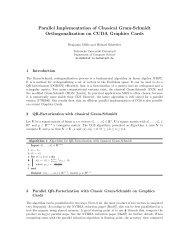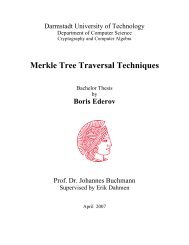Lattice Basis Reduction in Infinity Norm - Technische Universität ...
Lattice Basis Reduction in Infinity Norm - Technische Universität ...
Lattice Basis Reduction in Infinity Norm - Technische Universität ...
You also want an ePaper? Increase the reach of your titles
YUMPU automatically turns print PDFs into web optimized ePapers that Google loves.
For each step t > p of the algorithm, the <strong>in</strong>tegers (ũt+1, ...., ũs) are fixed.<br />
All left <strong>in</strong>tegers ut−1, for which Ft( �k i=t ũibi) < Fj(bj), are enumerated.<br />
S<strong>in</strong>ce Ft(−x) = Ft(x) for all x ∈ Rn if ũk = .... = ũt = 0 we<br />
could limit the search to only nonnegative <strong>in</strong>tegers. Every time a coefficient<br />
is computed it is organized <strong>in</strong> a search tree with depth k − j + 2.<br />
Currently the Depth-First-Search is considered most appropriate for the<br />
enumeration. With respect to the Euclidean norm and z ∈ R, the distance<br />
function Ft can be efficiently computed with the help of the Gram-Schmidt<br />
orthogonal system. From<br />
˜ct := � πt( �k i=t ũibi) �2 2 and ct := � ˆ bt �2 2 = � πt(bt) �2 2 , for 1 ≤ t ≤ k<br />
we get<br />
F 2 t ( � k<br />
i=t ũibi) = ˜ct = ˜ct+1 + (ũt + � k<br />
i=t+1 ũiµi,t) 2 ct<br />
−yt is the m<strong>in</strong>imal real po<strong>in</strong>t for yt := � k<br />
i=t+1 ũiµi,t. We get the whole<br />
m<strong>in</strong>imum through the symmetry<br />
ct(−yt + x, ũt+1, ...., ũk) = ct(−yt − x, ũt+1, ...., ũk)<br />
at the po<strong>in</strong>t νt := ⌈−yt⌋. Depend<strong>in</strong>g on whether νt > −yt holds true or<br />
not, we get a sequence of non-decl<strong>in</strong><strong>in</strong>g values ˜ct either <strong>in</strong> order (νt, νt − 1,<br />
νt + 1, νt − 2, ...) or <strong>in</strong> order (νt, νt + 1, νt − 1, νt + 2, ....).<br />
Algorithm 3.2 ENUM with Euclidean <strong>Norm</strong><br />
INPUT: j, k, b1, ...., bm<br />
1. • s := t := j, ¯cj := cj, ũj := uj := 1<br />
• νj := yj := ∆j := 0, δj := 1<br />
• FOR i = j + 1, ...., k + 1<br />
– ˜ci := ui := ũi := νi := ∆i := 0<br />
– δi := 1<br />
2. WHILE t ≤ k<br />
• ˜ct := ˜ct+1 + (yt + ũt) 2 ct<br />
• IF ˜ct < ¯cj<br />
• THEN<br />
– IF t > j<br />
– THEN<br />
∗ t := t − 1, yt := � s<br />
i=t+1 ũiµi,t<br />
∗ ũt := νt := ⌈−yt⌋, ∆t := 0<br />
∗ IF ũt > −yt<br />
∗ THEN δt := −1<br />
∗ ELSE δt := 1<br />
24





